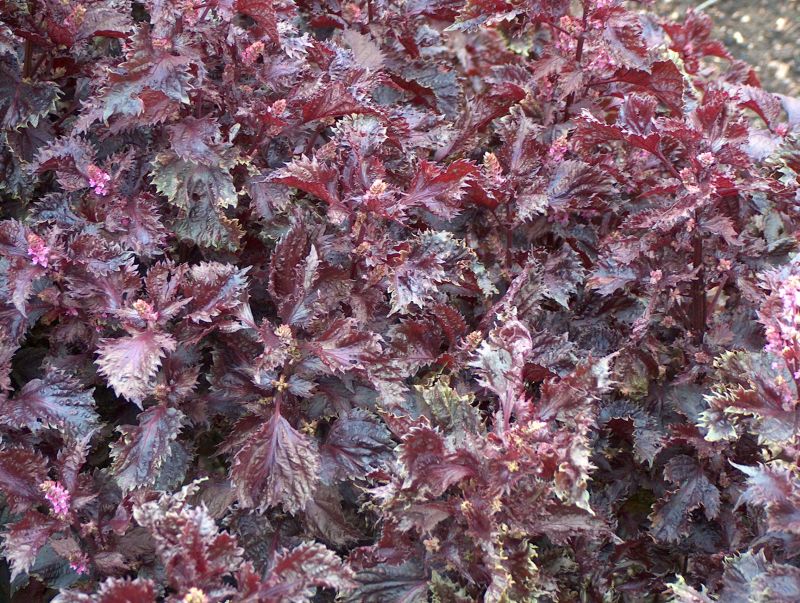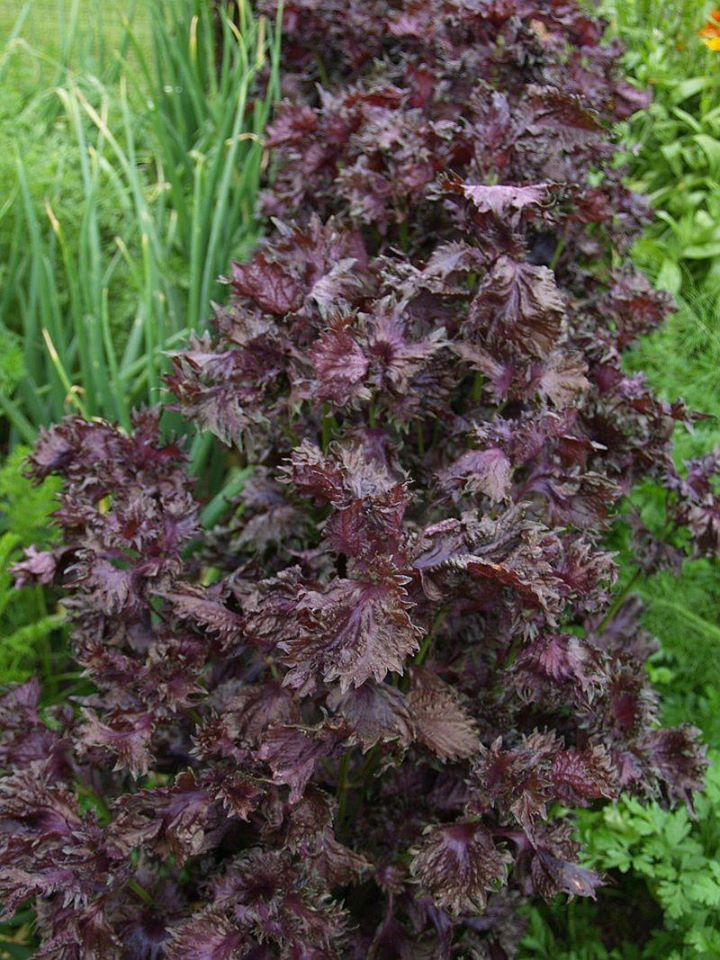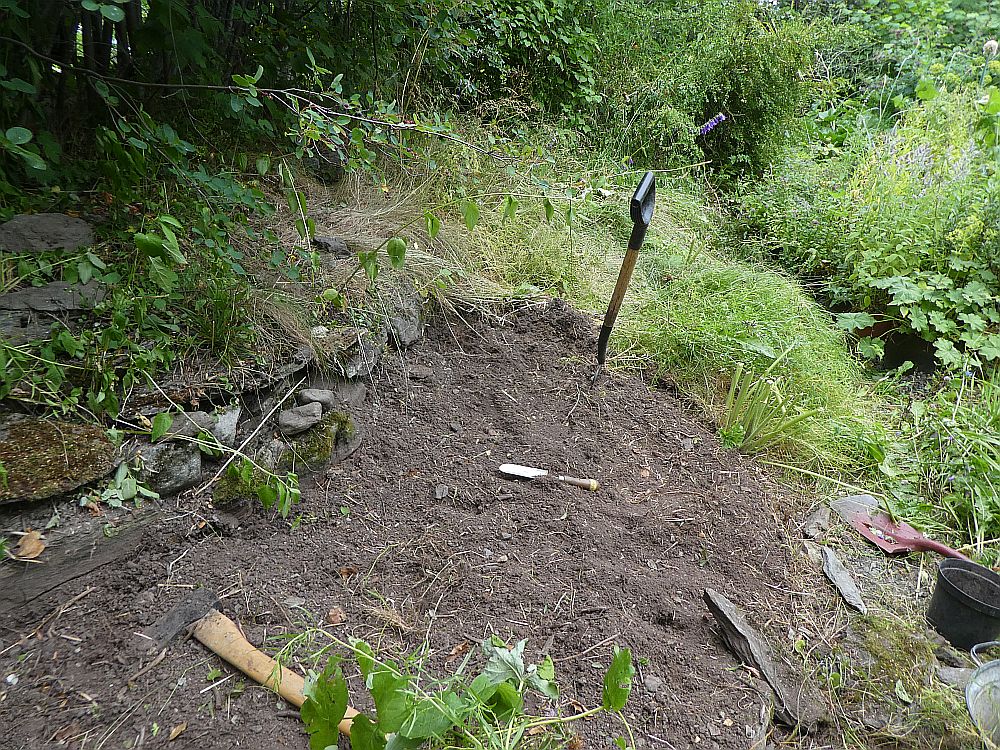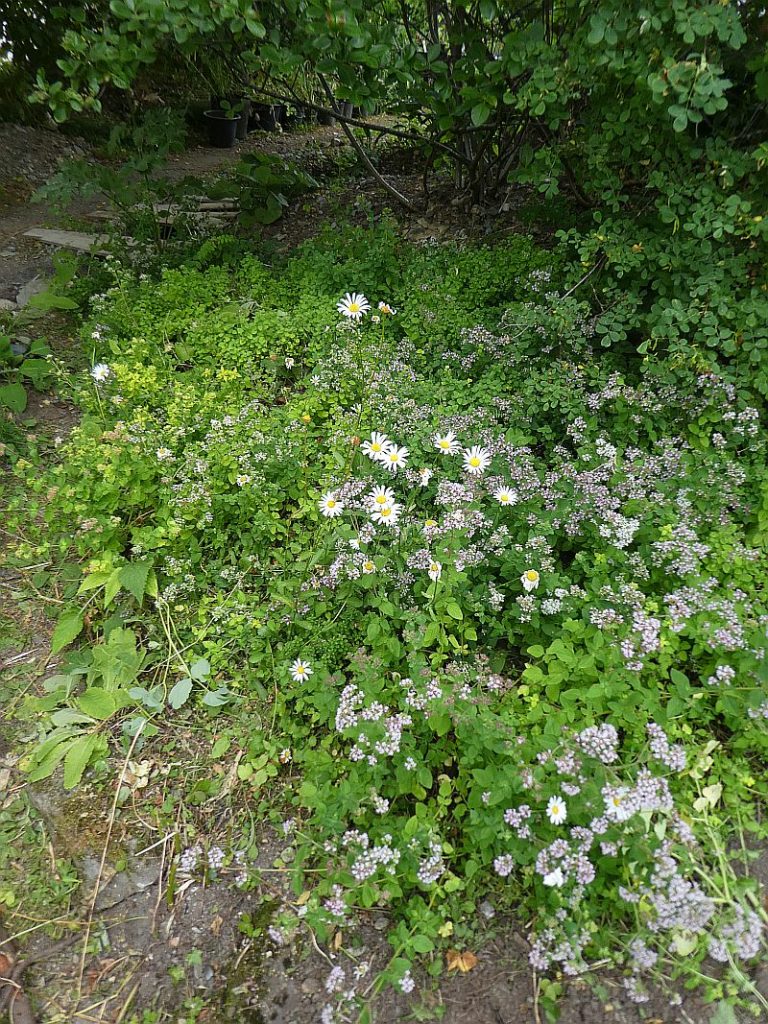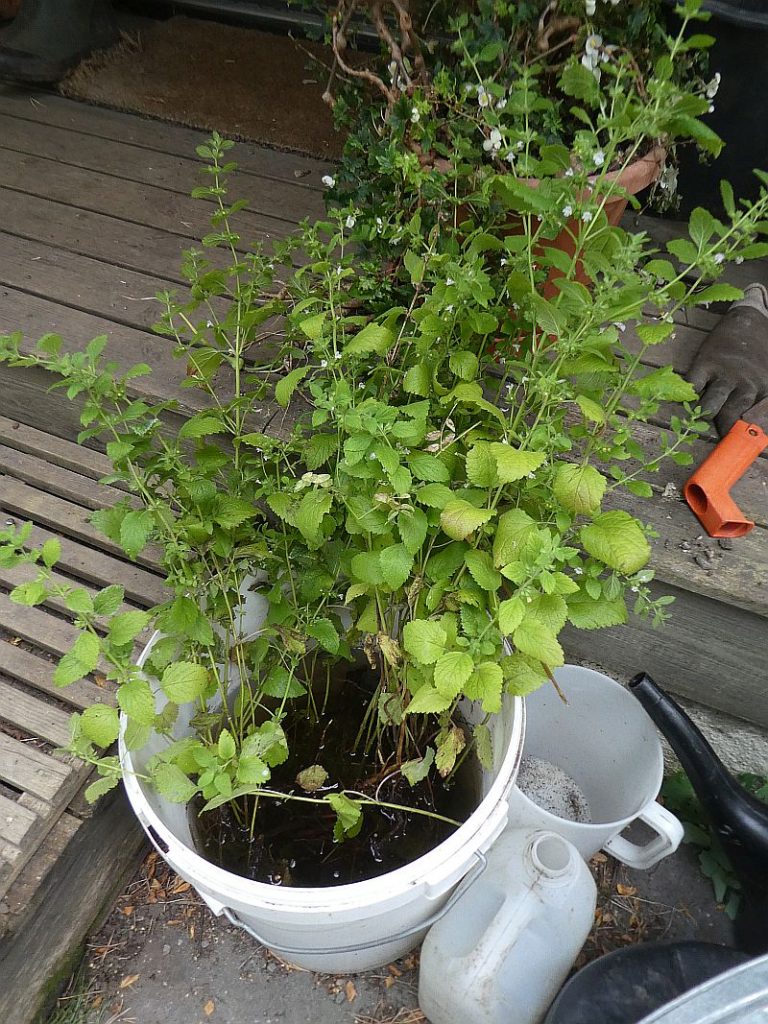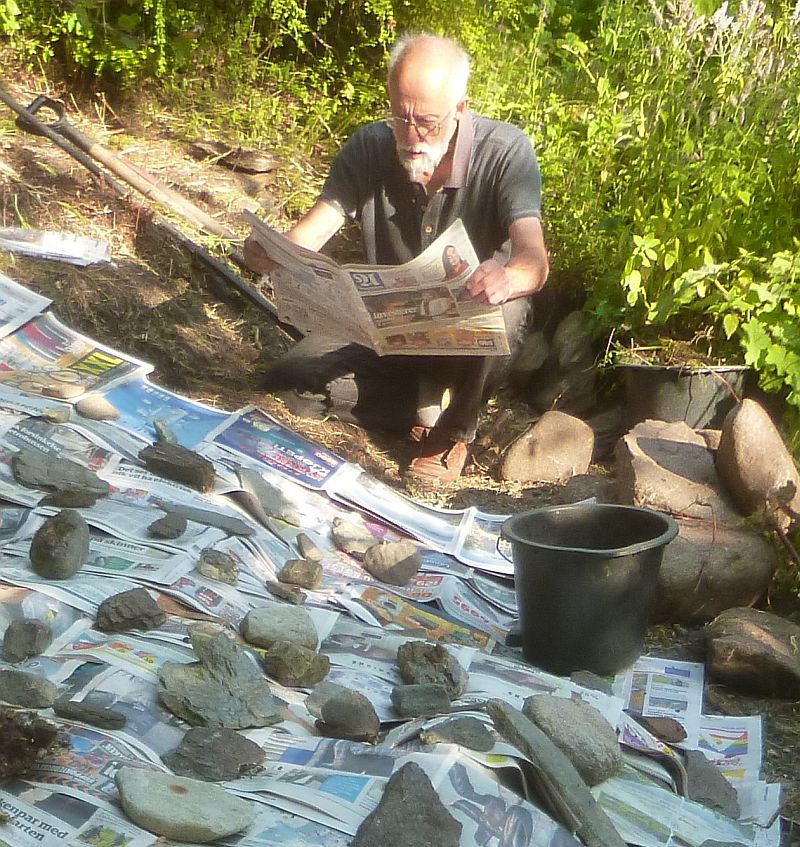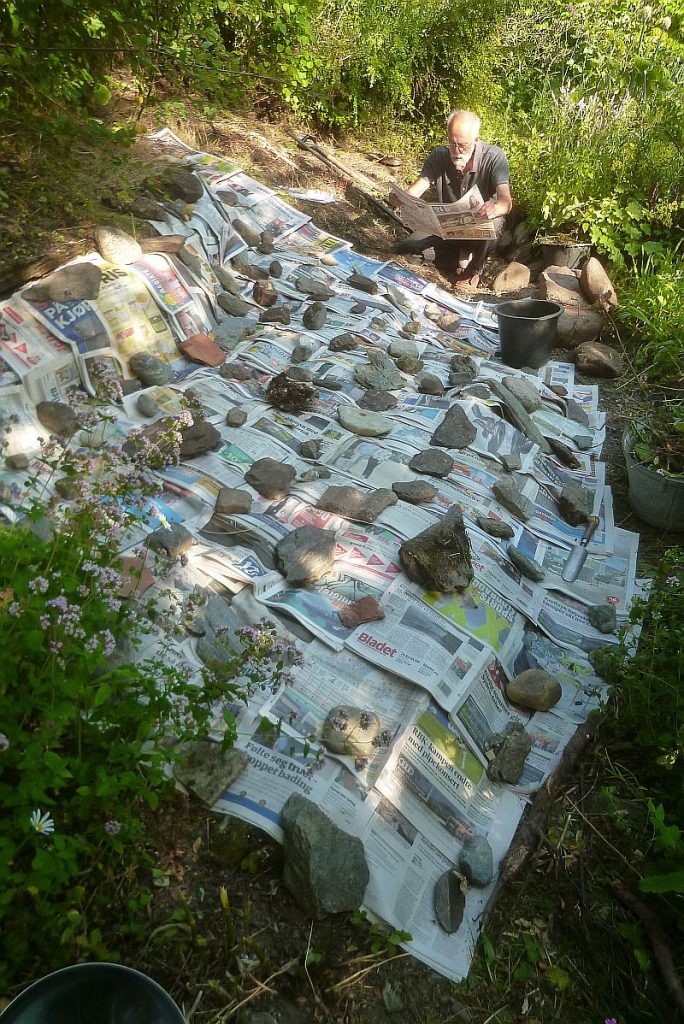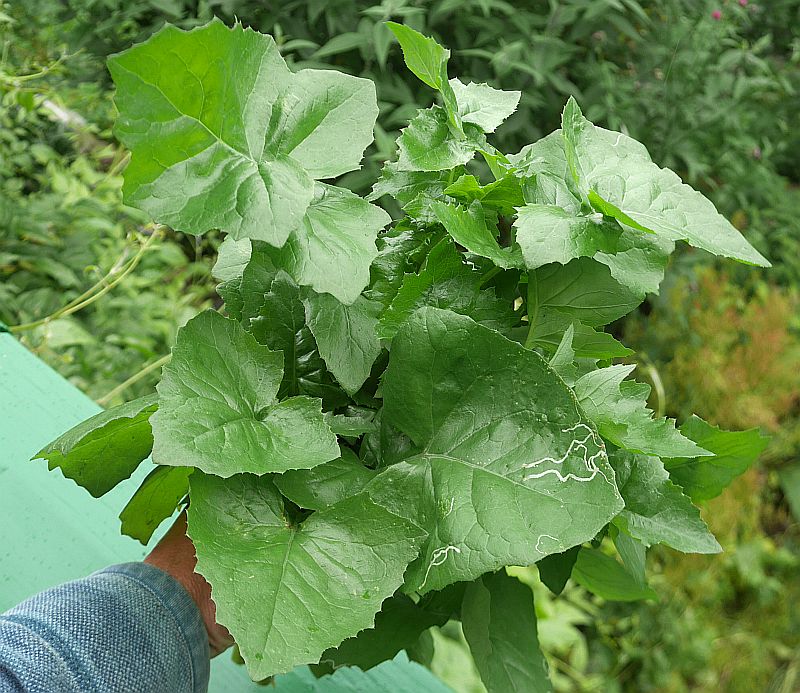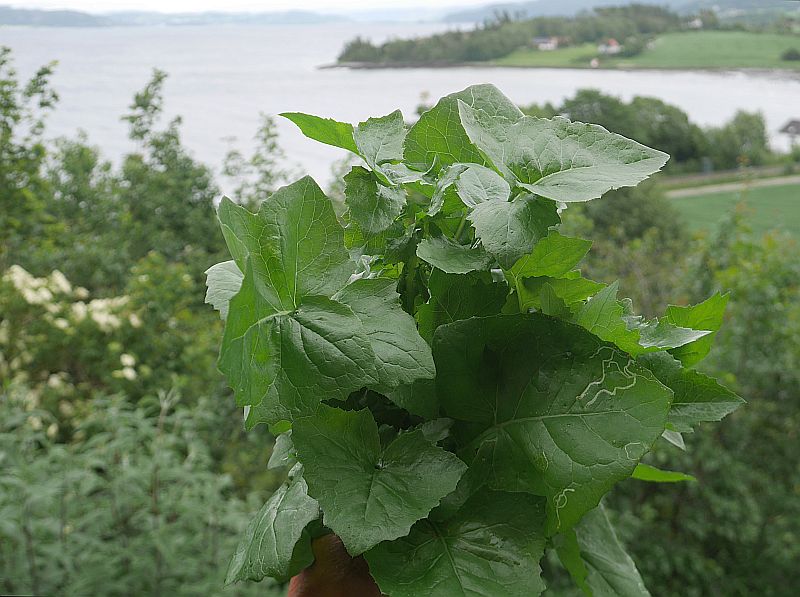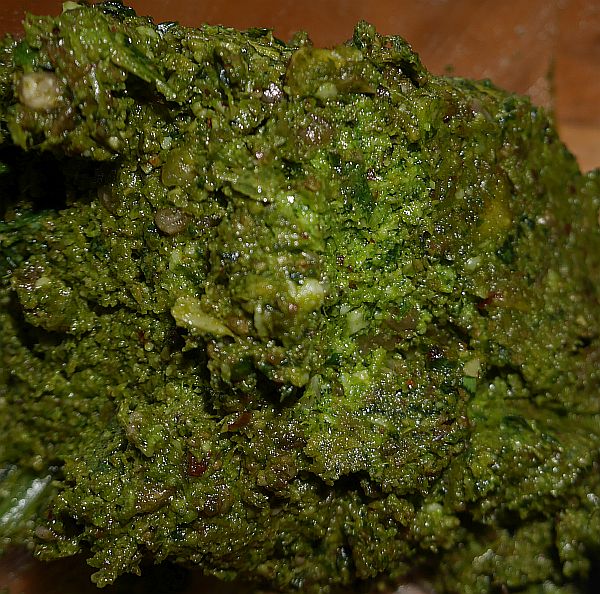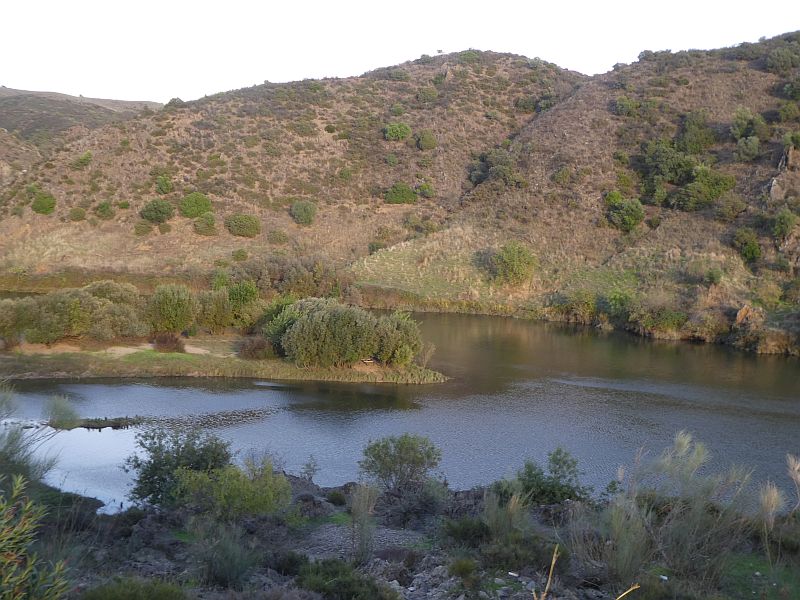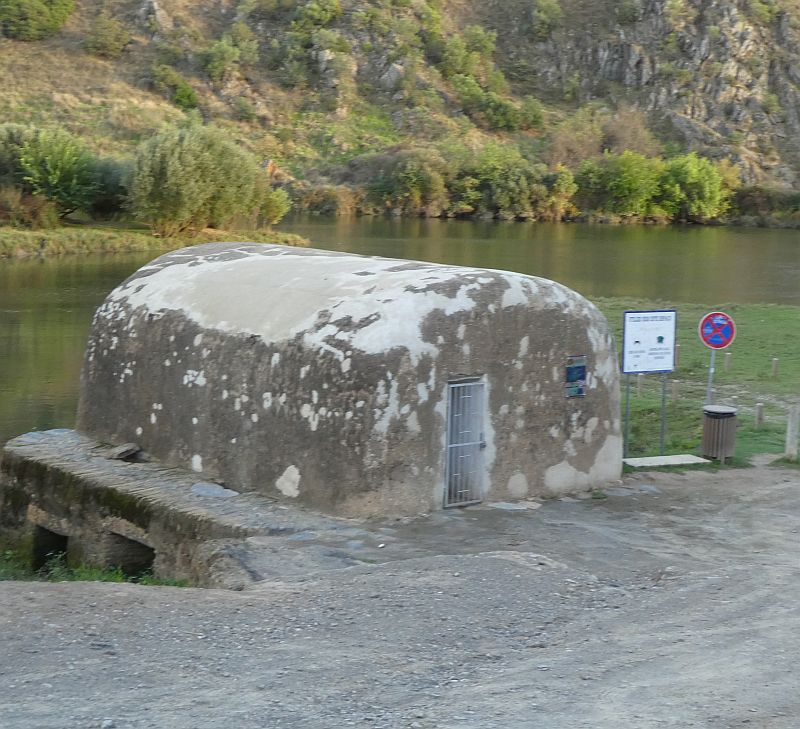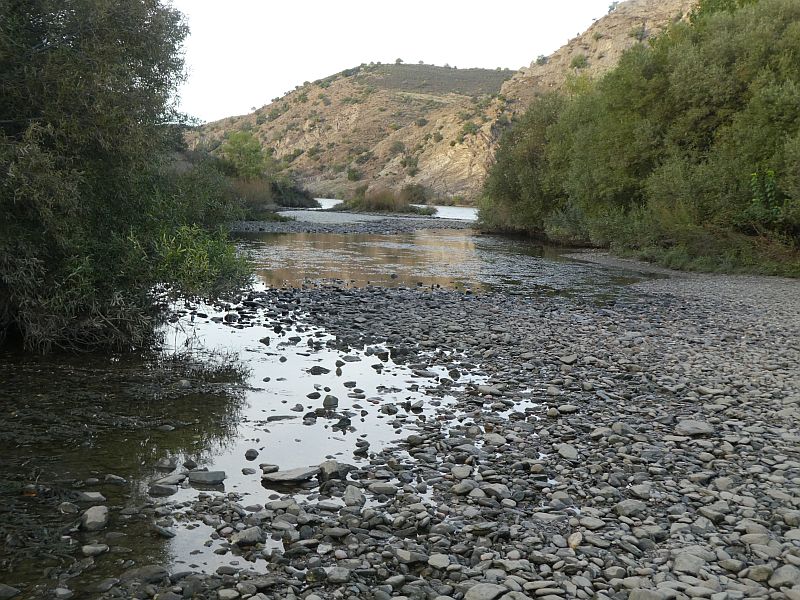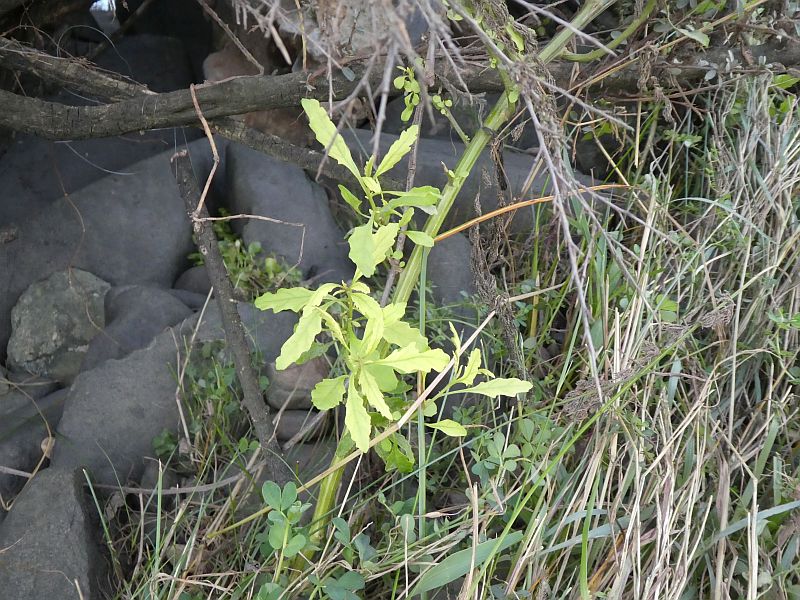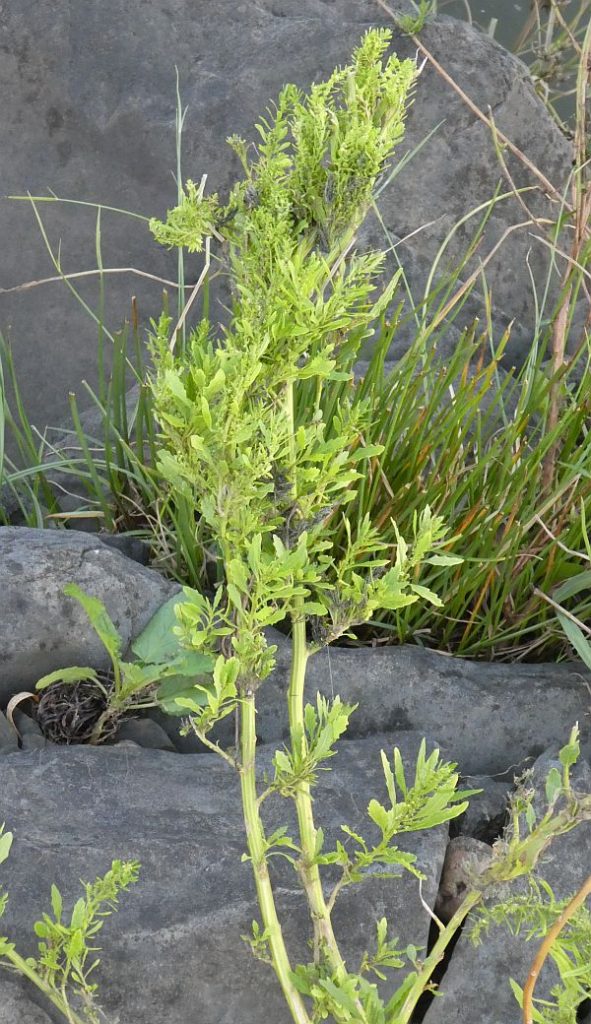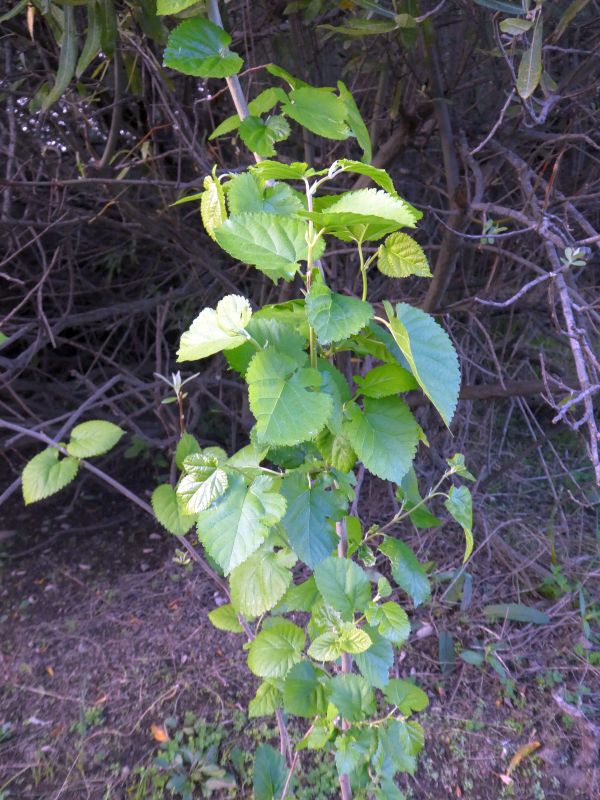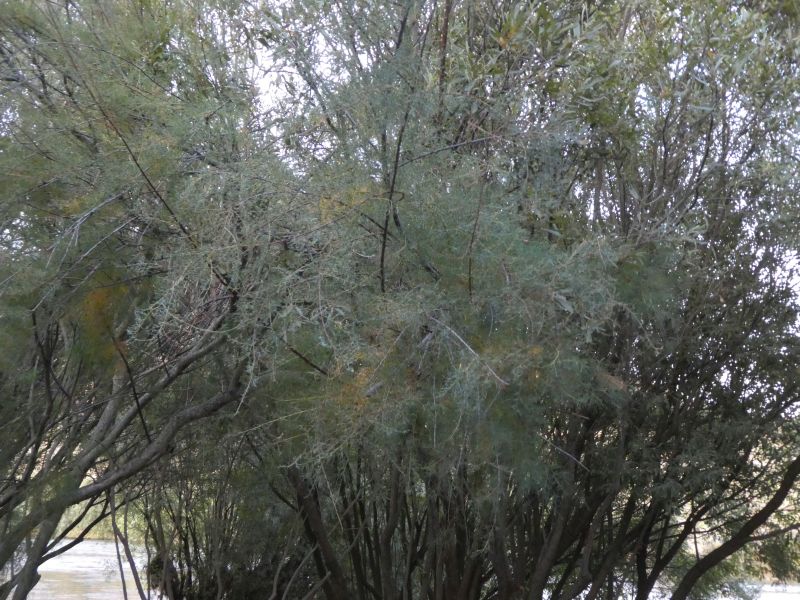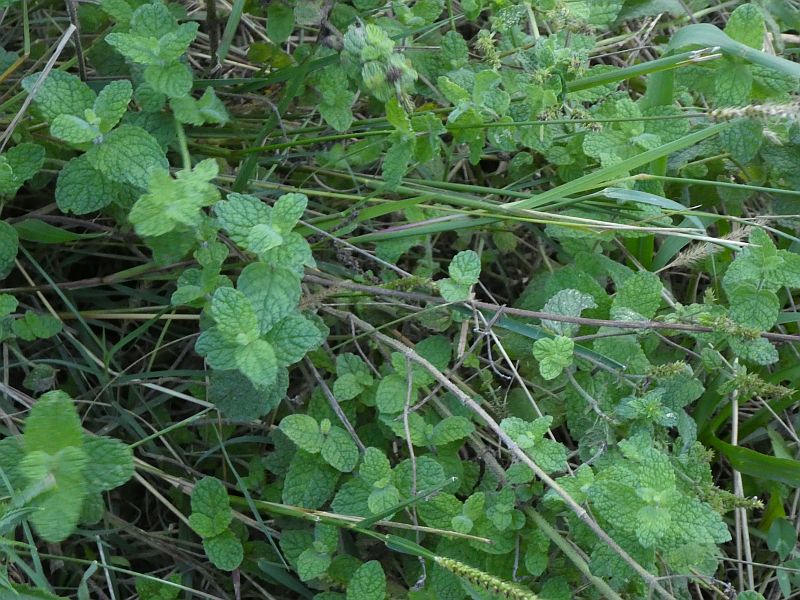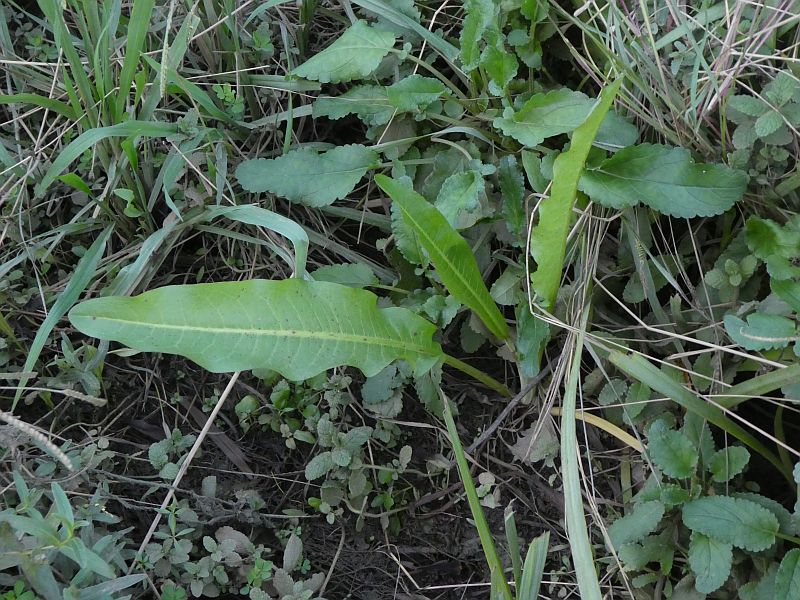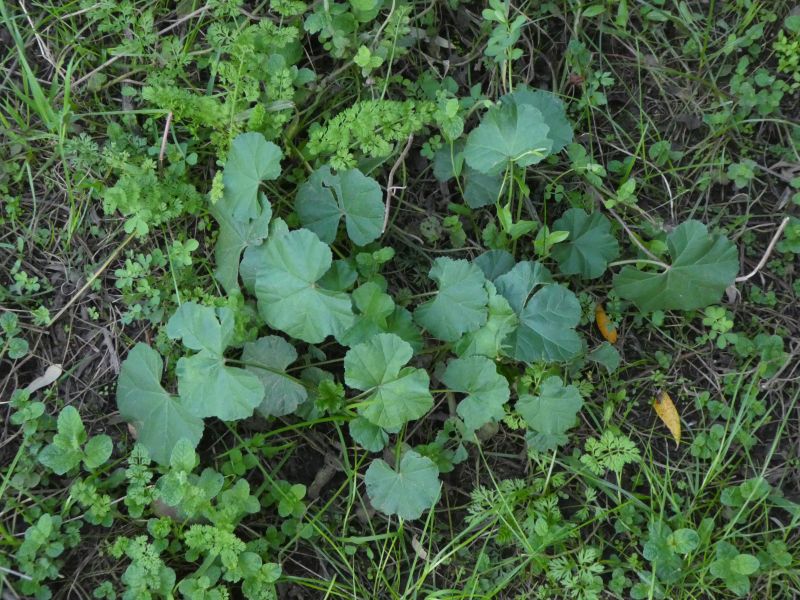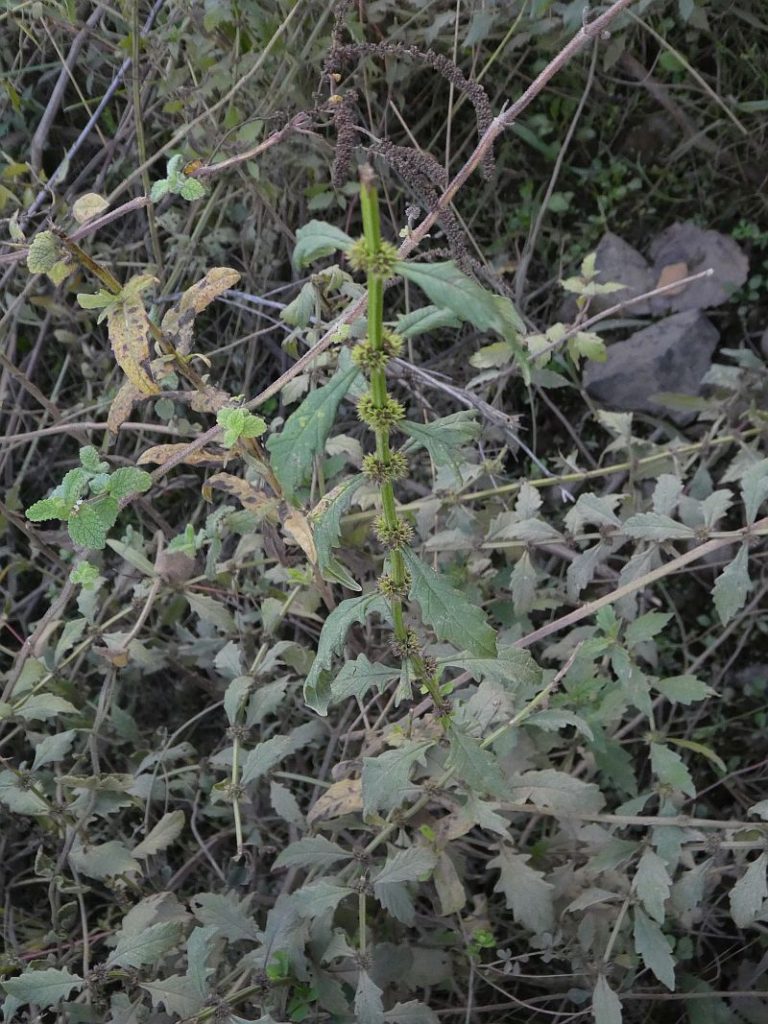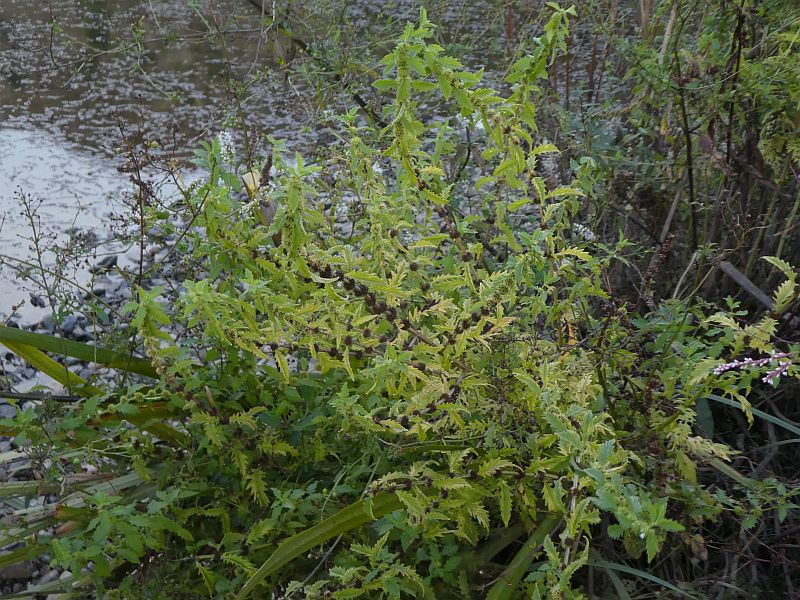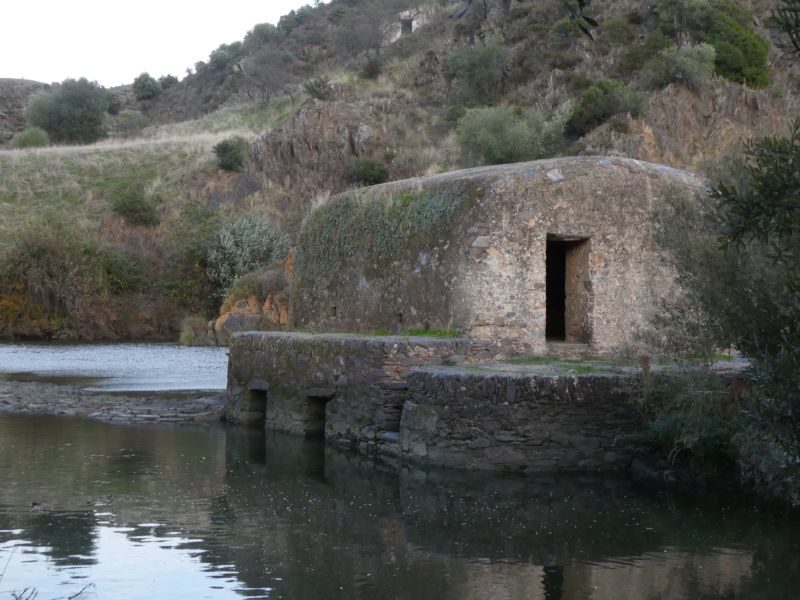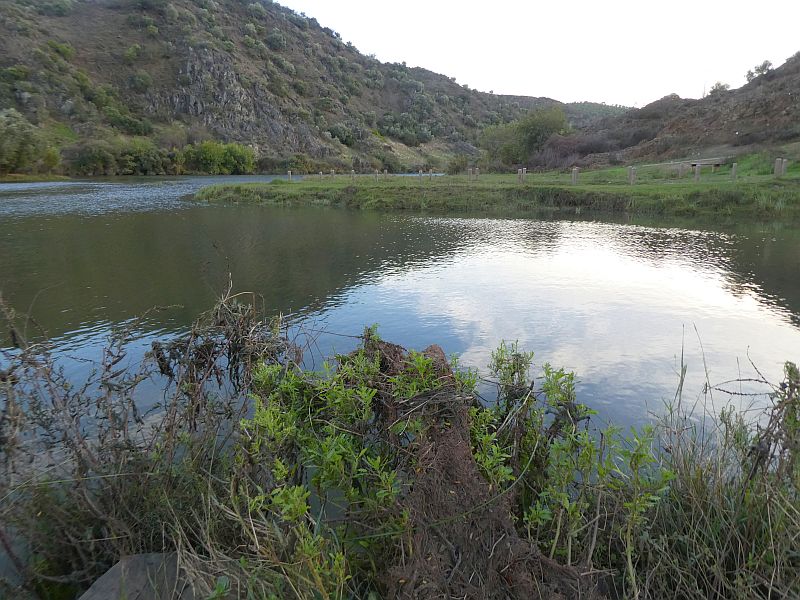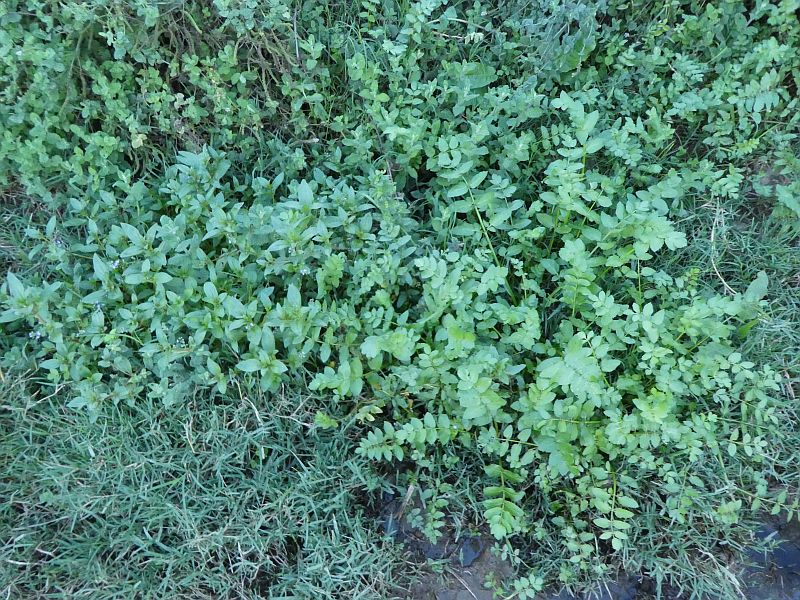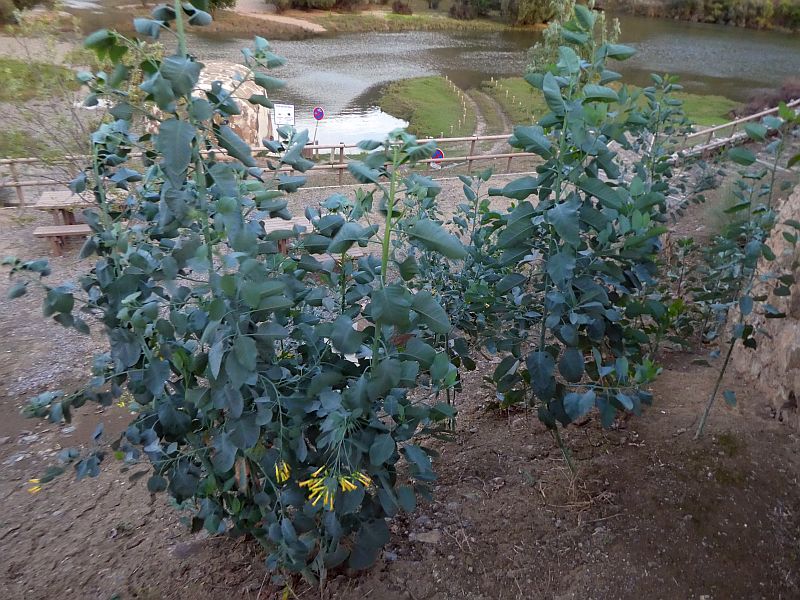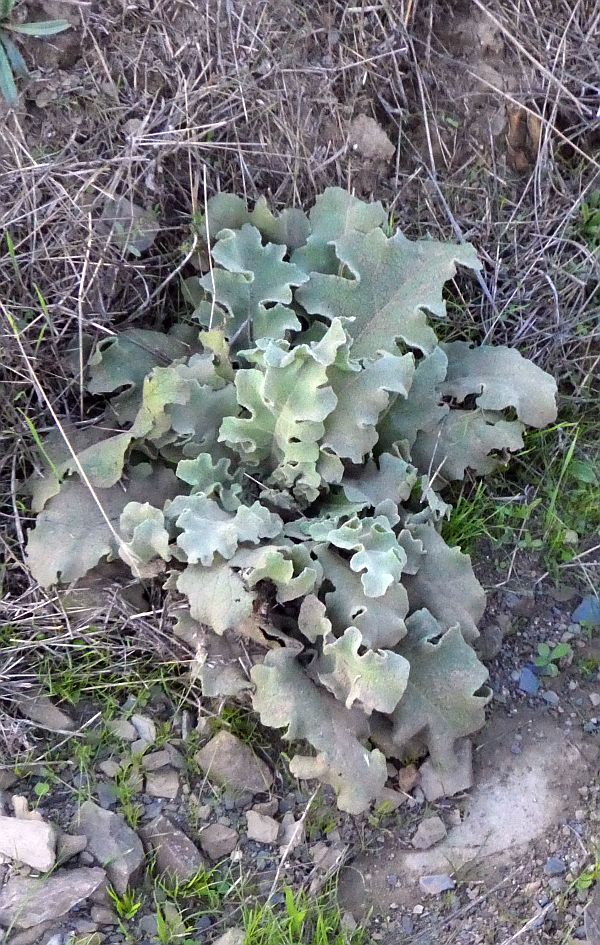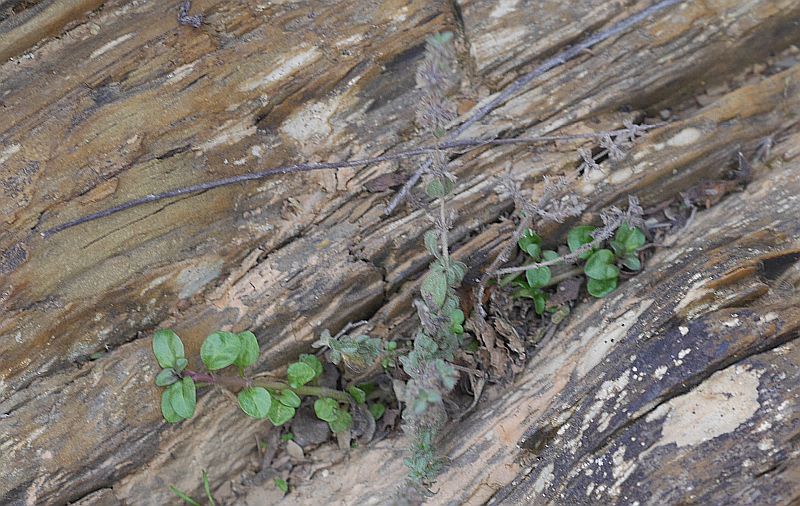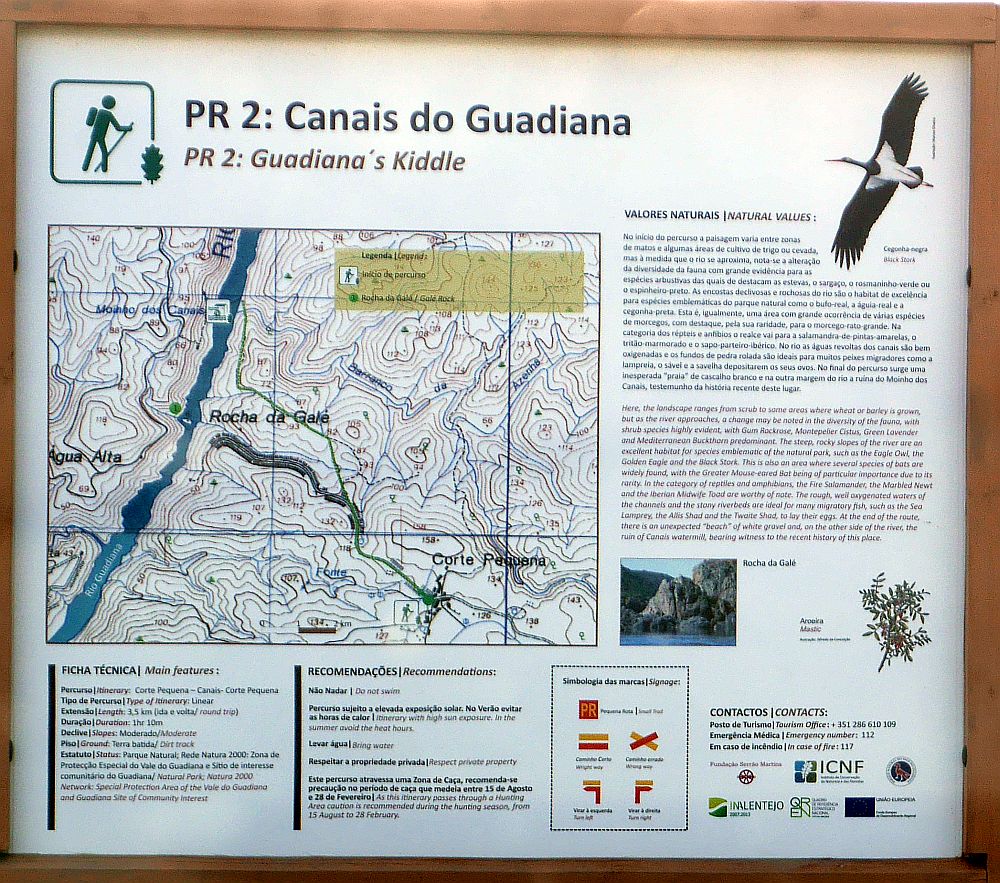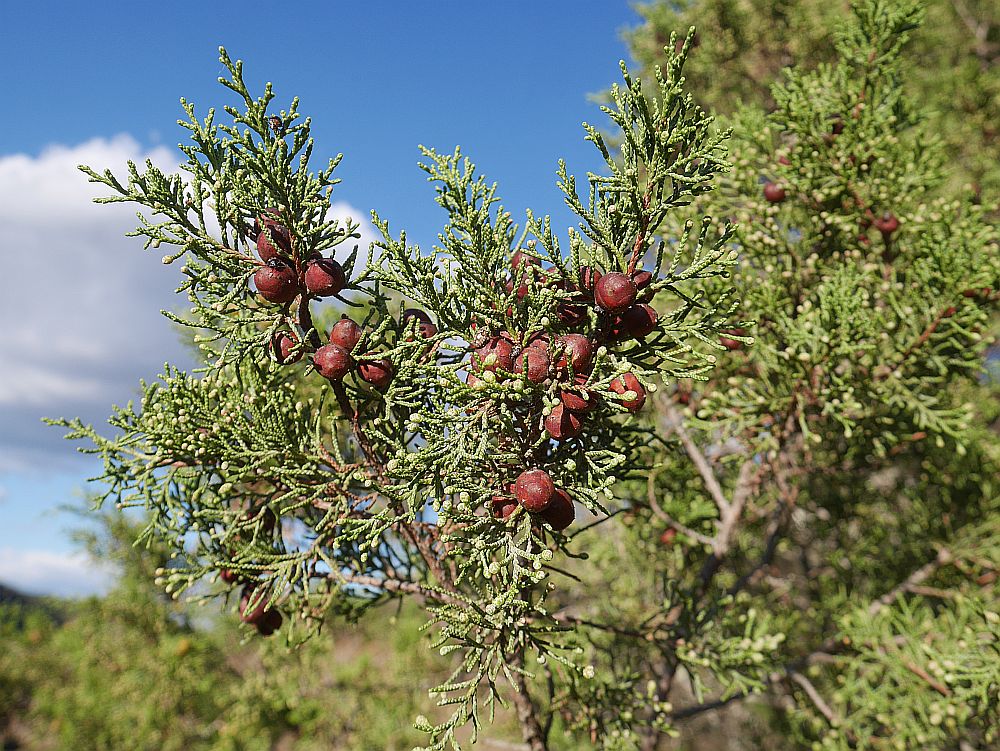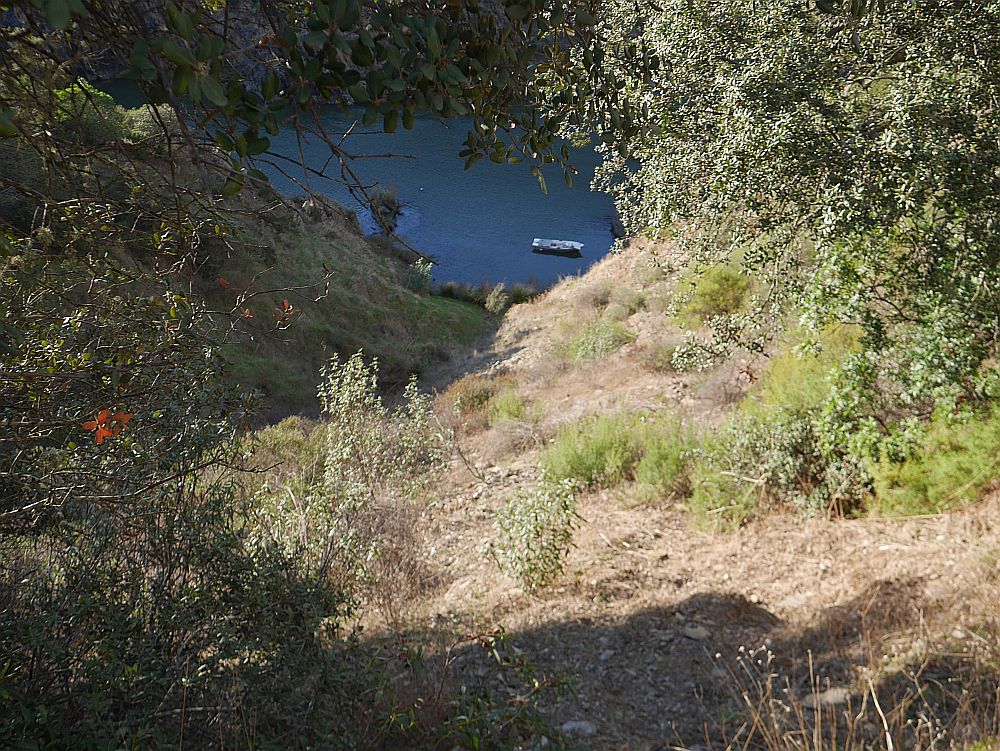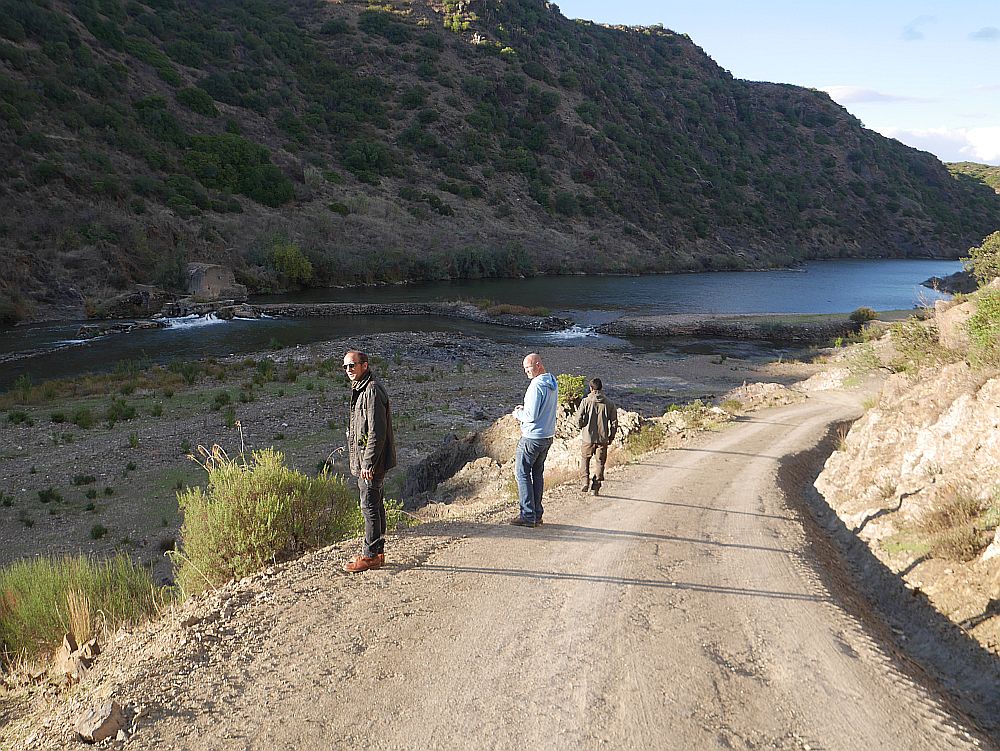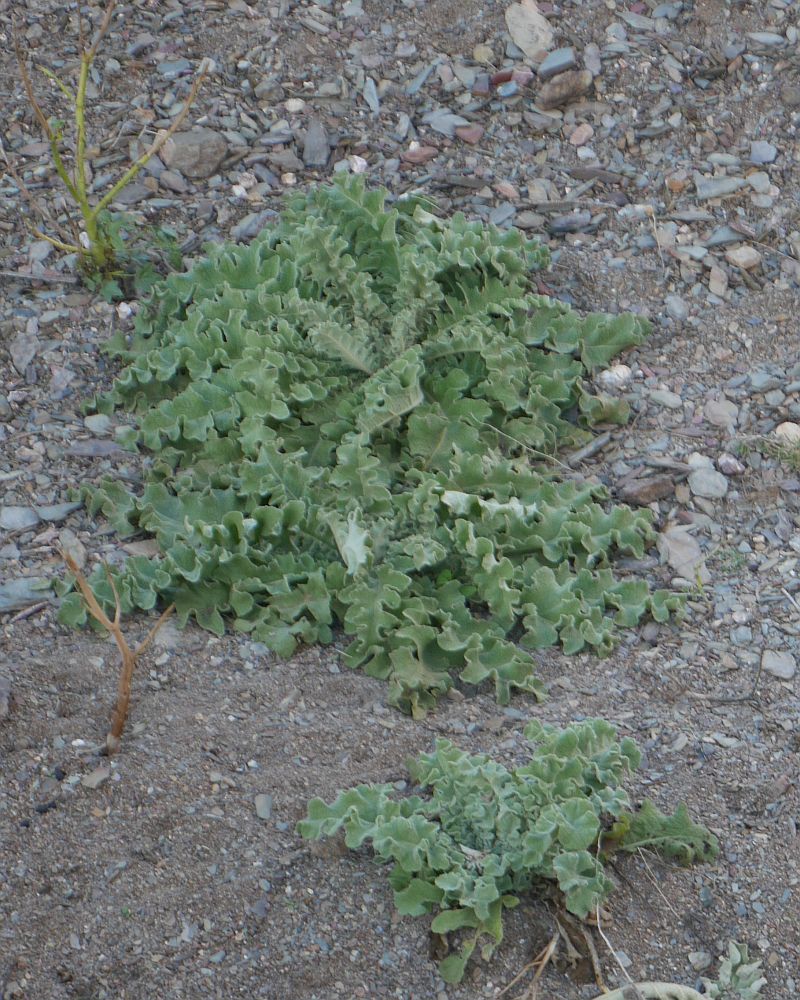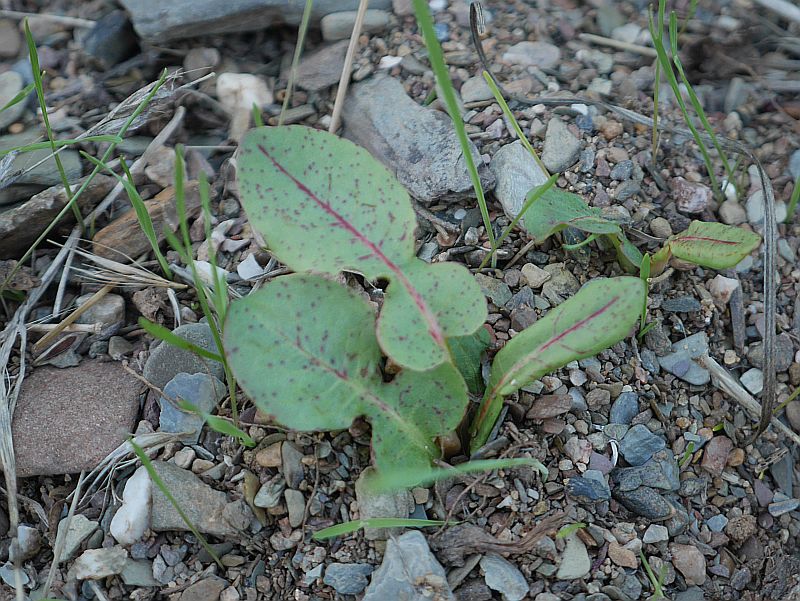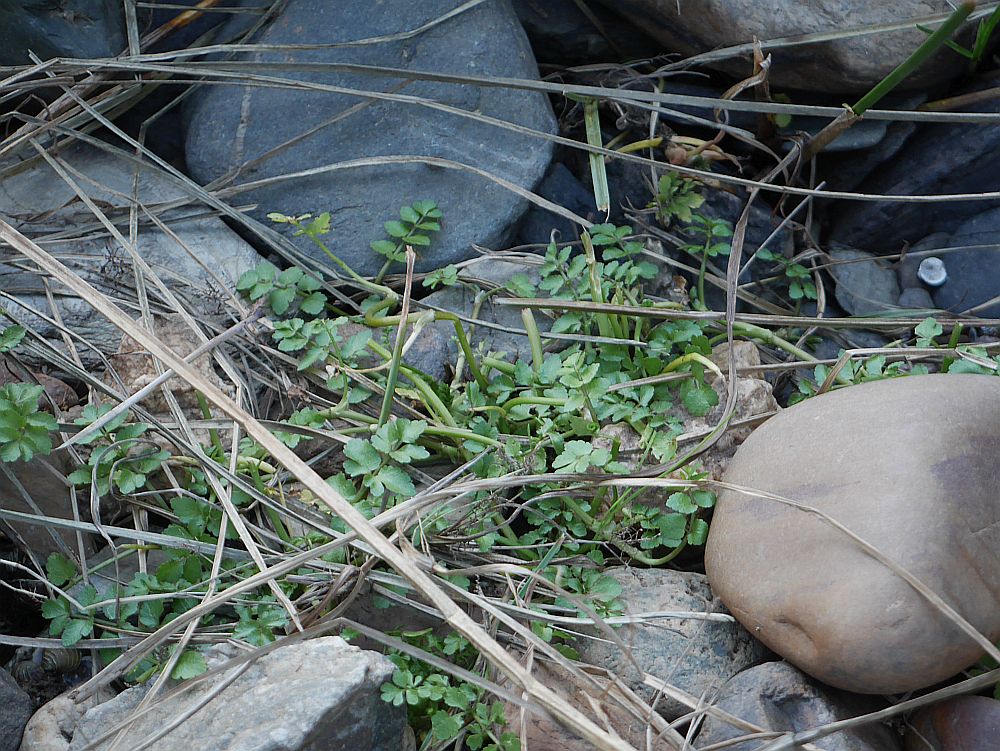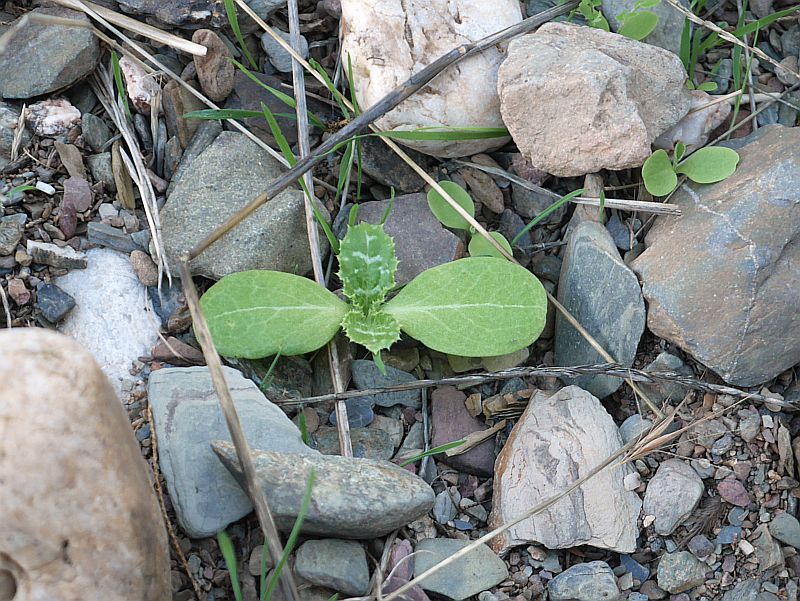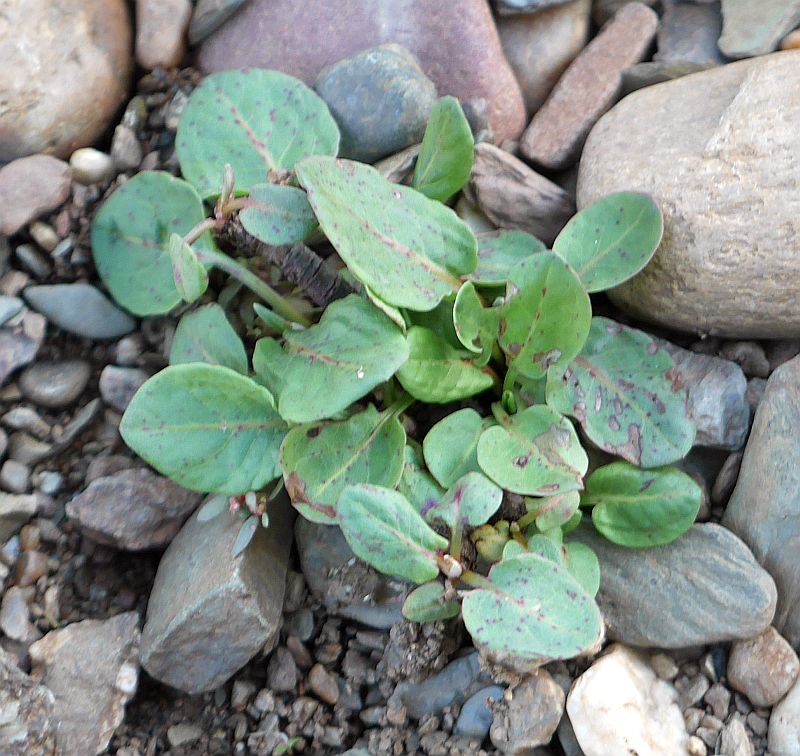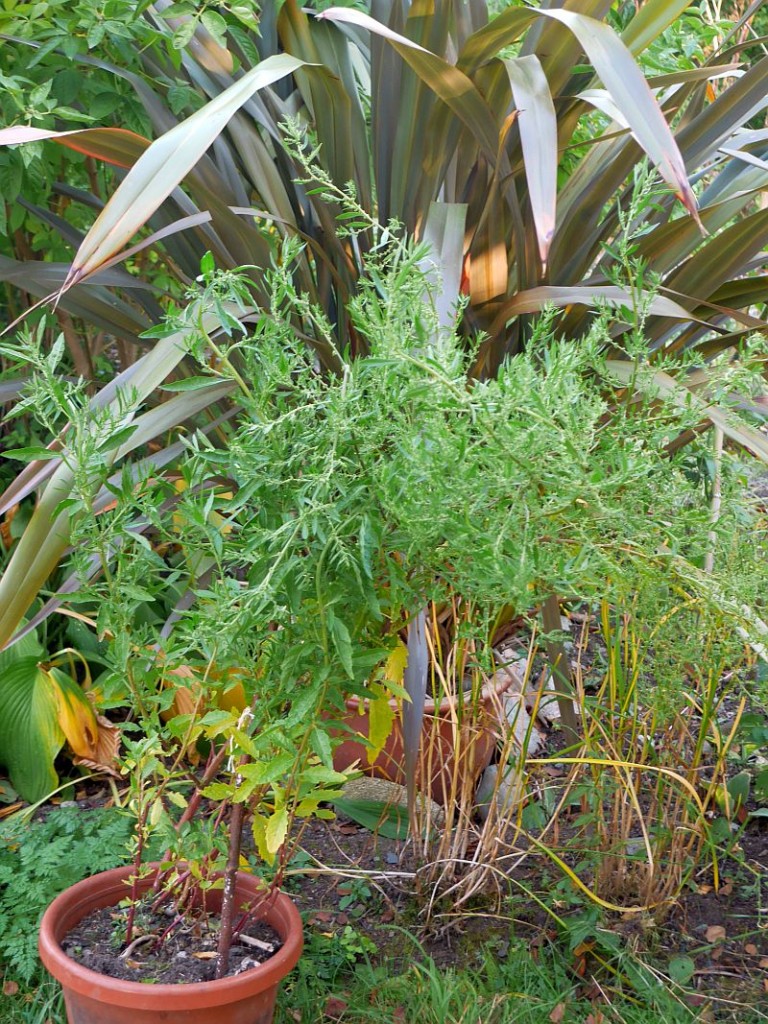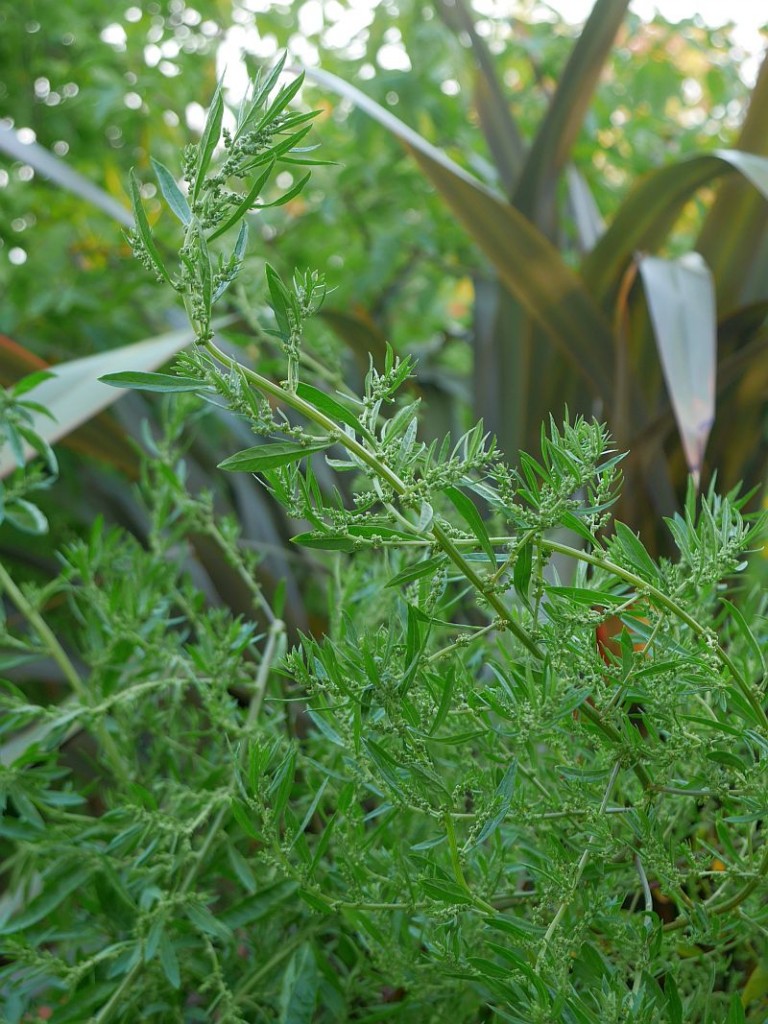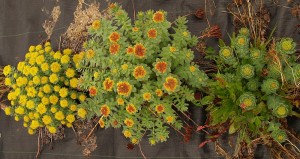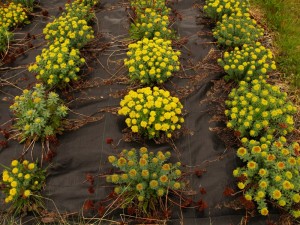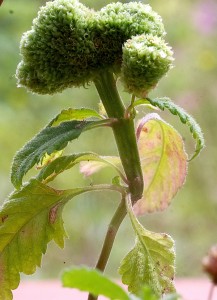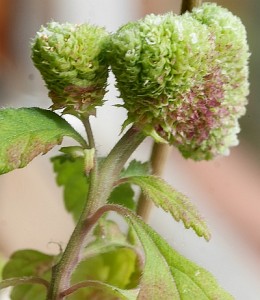Perilla frutescens var crispa f. purpurascens (red or purple shiso) is looking good on the window sill in front of my desk! This is an important crop in the Far East both used as a flavouring, a dye plant, as wraps (the seeds, seed oil and seed sprouts are also used). I’d love to use the leaves to colour pickled chinese artichokes (chorogi), as shown on the Backyard Larder blog (see https://backyardlarder.co.uk/plants/chinese-artichoke), but the chorogi aren’t ready until November. Maybe I’ll try drying some leaves!
I grow this annual indoors as it’s generally too cold outside here in summer. It’s also difficult to save seeds as it doesn’t start flowering until late autumn and usually dies rather than producing seeds, a dead end for me, but now and again someone offers me seed for trading as in this case!
Perilla is also of course commonly used as an ornamental in warmer areas like Southern England, but I’ve also seen it outside in Gothenburg in Southern Sweden.
Perilla is in the mint family and it’s also easy to make more plants by taking cuttings (like basil).
I most often use shiso in my mixed salads.
Category Archives: Herbs
Lemon balm rescue
However, a small birch tree became a large birch tree over the years and the roots spread throughout the bed and it became very dry. I had also introduced greater stitchwort / lundstjerneblom (Stellaria holostea) near the bed and it spread into the herb bed and, loving the dry conditions, spread through part of the bed and was difficult to control. Over the years, most of the herbs died, apart from the oreganos which thrived under these conditions and the lemon balm (sitronmelisse), despite the fact that this we hadn’t expected this to be hardy enough (we covered this part of the bed with leaves in winter to protect it for many years). English bluebells (Endymion non-scriptus) are also doing well, a bit of nostalgia from the old country!
I started today to clear this bed, rescuing valuable plants such as lemon balm and german tarragon (tysk estragon) which was planted here in 2010 and has liked the dry conditions. The oreganos will be left as they were. Once I’ve dug out as many of the plants as possible, I’ll cover with newspaper for a year before replanting.
Sonchus and Basil Pesto
I made a sow thistle basil pesto last night together with basil grown in my office at the botanical gardens! I’m an office basil grower of over 40 years, having started when I was a student in 1978 (see http://www.edimentals.com/blog/?p=5221, where I made pesto and Allium wallichii, the Sherpa or Nepal onion)
Last night I used garlic and more Johannes’ shallots (Allium x cornutum; see http://www.edimentals.com/blog/?p=22601)
On the Guadiana River
Vitor Menas and Fernando Garcia run the business and Fernando joined us on the walk and showed us around the workshop in the village.
Accidental companions

THE 2002 RINGVE RENAISSANCE MEGASALAD
The renaissance garden at the Ringve Botanical Garden in Trondheim was designed around a formal square garden divided into quarters, a common way to lay out gardens in the Renaissance period! This is a historic herb garden showing vegetables, medicinal and spice plants and ornamental plants that were grown in Trondheim in the 17th century. There are about 120 different plant species in this garden. In 1994, it was 300 years since Norway’s first gardening book, Horticultura was published. It was written by Christian Gartner, who was Trondheim’s first town gardener. It was in connection with the publication of the jubilee edition of this book that the renaissance garden at Ringve was established.
On the occasion of the reopening of the Renaissance Garden on 19 June 2002, Stephen Barstow from Bergstua Herb Garden in Malvik put together a renaissance salad specially composed for the occasion, solely from edible plants growing in the garden. In total, 80 different plants were used from the garden. This was also done to show the diversity of edible plants (and especially perennials) that can be grown in Trøndelag (an area mid-Norway). Barstow holds the unofficial world record in diversity salads from 2001 with 363 ingredients (see http://www.edimentals.com/blog/?p=206 and the Guinness rejection letter: http://www.edimentals.com/blog/?p=462)!
See also my 2006 renaissance salad made at the Trondheim Food Festival : http://www.edimentals.com/blog/?p=14325
In the following list, all the plants used in the salad mentioned and the location in the garden can be found on the map on the last page (from the numbers in front of each plant). In addition to the use in cooking (plant parts used for food are highlighted), other uses are also mentioned for each plant. Most plants were also used medicinally. We note that not every plant used in the salad was necessarily used in the Renaissance period as salad plants, but all have been used as salad plants somewhere in the world.
Inspiration (a salad from the Middle Ages):
”The Good Huswifes Jewell, Thomas Dawson, 1596
Take your hearbes and picke them very fine into faire water, and picke your flowers by themselves, and wash them all cleane, and swing them in a strainer, and when you put them into a dish, mingle them with Cowcumbers or Lemmans payred and sliced, and scrape Suger, and put into vineger and Oyle, and throw the flowers on the top of the Sallet, and of every sorte of the aforesaid thinges, and garnish the dish about with the foresaide thinges, and hard Egges boyled and laid about the dish and upon the Sallet. ”
The salad dressing contained sunflower oil, vinegar and garlic!
!(103) Achillea millefolium (Ryllik): Ungblad; Øl smaks-tilsetning; Te-erstatning under krigen. Viltvoksende i Trøndelag.
(57) Acorus calamus (Kalmusrot): Rot som grønnsak og kandidisert; Krydder (aromatisk); ung stilk og blad.
(84)= Allium ascalonicum (Sjalottløk): Hele planten (grønnsak og salatplante)
(73) Allium cepa var. viviparum (Luftløk): Hele planten (grønnsak og salatplante)
(43) Allium fistulosum (Pipeløk):: Hele planten (grønnsak og salatplante)
(81) Allium sativum (Hvitløk): Hele planten (grønnsak og salatplante). Brukt i salatdressing.
(101) Allium schoenoprasum (Gressløk): Hele planten (grønnsak og salatplante). Blomstene brukes til pynt.
(94) Althea officinalis (Legestokkrose) : Blad og blomst (grønnsak og salatplante); “Marshmallows” stammer fra innkokt saft av røttene til legestokkrose
(115) Anchusa officinalis (Oksetunge): Blad og ungskudd (kokt)
(29) Anethum graveolens (Dill): Blad, blomsterstand og frø. Velkjent krydderplante. Te. Dill-olje brukes i matindustri. Kryddelikør.
(28) Angelica archangelica ssp. archangelica (Fjellkvann): Skrelt bladstilker. Kan også syltes med sukker og sitron eller sammen med rabarbra. Rot (kokt). Olje brukt i matindustri. Frø som krydder i Chartreuse (Likør). Vossakvann tidligere dyrket I Norge (mildere smak). Viltvoksende i Trøndelag.
(72) Apium graveolens var. dulce (Selleri): Stilk og blad. Frø brukes som krydder. Vanlig grønnsak som er lett å dyrke i Trøndelag.
(66) Armoracia rusticana (Pepperrot): Rot og unge blad. Frø. Pepperrotsaus er oftest brukt med fiskeretter. Kan finnes forvillet i Trøndelag.
(117) Artemisia abrotanum (Abrodd): Ung skudd brukt som krydder i kaker, salat osv.
(70) Artemisia dracunculus (Fransk Estragon): Blad. Krydder. Ingrediens i estragoneddik, bearnaisesaus, tartarsaus og hollandaisesaus.
(90) Asparagus officinalis (Asparges): Ung skudd.
(93) Atriplex hortensis (Hagemelde) : Blad. Brukes rå eller kokt. Fargeplante – blå (fra frø).
(33) Barbarea vulgaris (Vinterkarse): Blad. Brukes rå eller kokt. Vanlig forvillet plante i Trøndelag.
(13) Bellis perennis (Tusenfryd): Blad og blomst.. Rå eller kokt.
(116) Beta vulgaris var. cicla (Mangold): Blad og stilk.
(77) Borago officinalis (Agurkurt): Blad og blomst. Krydder i drikker. Blomst i isbiter. Urte-te. Fargeplante – blå (fra blomstene).
(89) Brassica nigra (Svart sennep): Frø, blad, blomsterskudd. Frøspirer. Salat. Krydder.
(30) Brassica oleracea var. ascephela (Grønnkål): Blad, blomsterskudd. Brukes rå eller kokt.
(122) Brassica oleracea var. sabauda (Savoykål): Blad. Brukes rå eller kokt.
(32) Calendula officinalis (Ringblomst) : Ung Blad, Blomster. Brukes i salat. Tørket blomst i kaker. Gul fargestoff (saffron erstatning). Urte-te (blomst).
(51) Campanula latifolia (Storklokke): Ung skudd om våren (rå eller kokt). Blomster i salat.
(119) Carum carvi (Karve): Bladrosetter (om våren, brukt i Norge til Karvekålsuppe) og frø (krydder i Akevitt, i brødbakst, i surkål osv.). Vanlig viltvoksende i nærheten av dyrkamark og ved kysten i Trøndelag. NB! Forsiktig – giftige forvekslings arter finnes!
(111) Chamomilla recutita (Kamomille) : Blad. Te-plante. Krydder. Olje brukt i parfymeri. Gul fargestoff.
(39) Chrysanthemum balsamita (Balsam) : Blad og blomst. Rå i salat. Urte-te (tørket blad). Brukt før i øl (før humle).
(14) Cichorium intybus (Sikkori): Blad og blomst. Rå eller kokt. Røtter brukt som kaffe-erstatning.
(120) Dianthus barbatus (Busknellik) : Blomstene. I salat, fruktsalat, i kaker og saft.
(67) Filipendula ulmaria (Mjødurt): Ungblad, blomst og rot. I Urte-te, salat, fruktsalat. Tidligere brukt i øl og mjød. Prøv blomster som smakstilsetning i syltetøy og supper.
(109) Foeniculum vulgare (Fennikel): Blad, stilk, blomster – rå eller kokt. Frøene er aromatisk og brukes i sauser, fiskeretter, i kaker osv.; Frø kan også spires og brukes i salat. Rot – som grønnsak; Urte-te (blad eller frø). Fennikel olje (fra frøene) brukes i matindustri, parfymeri, tannpasta osv.; Fargeplante – brun og gul.
(2) Helianthus annuus (Solsikke): Frø – brukes i frokostblandinger, i brødbakst, i solsikkesmør (laget som Peanøttsmør). Solsikkeolje kan kjøpes i Norge (er med i vår salatdressing). Frøspirer er god i salat. Unge blomsterknopper brukes som grønnsak (som med artiskokk). Kaffeerstatning. Solsikkeolje har flere industrielle anvendelser. Fiberplante (feks. et slags papir). Fargeplante – gul.
(88) Helianthus tuberosus (Jordskokk): Knollene rå eller kokt. Kaffeerstatning. Jordkokker var mer vanlig dyrket enn potet i Trondheim før 1750. Biomass plante brukt i alkohol produksjon.
(1) Humulus lupulus (Humle): Mest kjent som krydder i øl (tørket hunn blomster). Men, det er få som er klar over at ungskuddene kan brukes om våren som en grønnsak (et slags asparges). Vi har sett humleskudd på marked i Italia. Urte-te fra blad og blomstene. Røttene har også vært brukt som grønnsak. Fargeplante – brun; Humleolje (fra blomstene) i parfymeri. Fiberplante (ligner hamp, men ikke så sterk), har også vært brukt til å lage en brun papir.
(15) Hyssopus officinalis (Isop): Blad og ungskudd – rå eller som krydder i varm mat. Blomster – rå i salat. Isopolje brukes i parfyme- og mat-industrier. Brukes i pot-pourri.
(92) Inula helenium : Blad – kokt blad var brukt av Romerne. Røttene skal også være spiselig. Et olje kan frembringes av roten (aromatisk). Blå fargestoff (rot).
(18) Lavandula angustifolia (Lavendel): Blad og blomster – i små mengder i salat, supper osv. Urte-te (blomst); Blomstene kan også brukes i iskrem, syltetøy osv. Lavendelolje som smakstilsetning i matindustri, i parfymeindustri (i Eau de Cologne og såper). I pot-pourri.
(110)Levisticum officinale (Løpstikke): Ungblad og stilk – rå eller kokt. Frø – i salat eller kokt mat. Rot – Kokt grønnsak. Olje fra røttene brukes i matindustrien og parfymeri.
(78) Malva alcea (Rosekattost) : Blad – rå eller kokt. Blomst – i salat. Frø – rå.; Fiberplante. Fargeplante – gul og grønn.
(86) Malva sylvestris (Apotekerkattost) : Blad – rå eller kokt.Umodne frø og blomstene er god i salat. Te-erstatning. Fiberplante. Fargeplante – gul og grønn.
(38) Melilotus officinalis (Legesteinkløver) : Ungskudd – kokt som asparges; Fersk blad og blomst – rå eller kokt. Røttene brukt som grønnsak av Kalmuk folket i Mongolia.
(98) Melissa officinalis (Sitronmelisse) : Blad – rå eller kokt. Urte-te. Er brukt i likørene Chartreuse og Benedictine.
(47) Mentha aquatica (Vassmynte): Viltvoksende mynte. Blad – i salat, kokt mat, bakverk og dessert. Urte-te.
(55) Mentha piperita (Peppermynte): Blad – i salat, kokt mat, bakverk og dessert. Myntesaus til bl.a. nypoteter. Urte-te.
(54) Mentha spicata (Grønnmynte/ Engelskmynte) : Blad – i salat, kokt mat, bakverk og dessert (feks. fruktsalat). Myntesaus til bl.a. nypoteter. Urte-te.
(49) Mentha spicata var. crispa (Krusmynte): Blad – i salat, kokt mat, bakverk og dessert (feks. fruktsalat). Myntesaus til bl.a. nypoteter. Urte-te.
(26) Meum atamanticum (Bjørnerot): Blad – i salat og i diverse varme retter. Røtter – kokt.
(87) Myrrhis odorata (Spansk Kjørvel): Blad og rot – rå eller kokt. I supper, stuinger, i kokevann til kål; I frukt som rabarbra for å nøytralisere syren. Unge frø – rå (lakris smak spesielt likt av barn).
(97) Origanum vulgare (Kung eller Bergmynte): Viltvoksende nær Trondheim. Blad og blomster – rå eller kokt. Urtete. Kjent krydder i retter fra Middelhavet (feks. Pizza).
(76) Papaver somniferum (Opiumvalmue): Frø – rå eller kokt. I brødbakst, kaker osv.
(46) Petroselinum hortense var. foliosum (Persille) – Blad – rå eller kokt. Urtete. Persilleolje (fra blad) brukes av matindustrien som smaktilsetning og i parfymeindustri (for menn).
(37) Peucadanum ostruthium (Mesterot): Blad – kokt.
(82) Phaseolus vulgaris (Hagebønner) : Tørket eller umodne frø og frøkapsler som grønnsak eller i salat. Bønnespirer. Kaffeerstatning (fra frø). Unge blad – rå eller kokt.
(121) Plantago lanceolata (Smalkjempe) : Unge blad – rå eller kokt. Frø – kokt eller på brødbakst (som valmuefrø).
(31) Plantago major (Groblad) : Unge blad – rå eller kokt. Frø – kokt eller på brødbakst (som valmuefrø). Te erstatning.
(114) Polygonum bistorta (Ormrot) : Blad – spinat vekst. I England er dette en viktig ingrediens i Easter Ledge Pudding, en tradisjonell vår-rett. Frø – rå eller kokt; Røtter – rå eller kokt.
(10) Primula elatior (Hagenøkleblom) : Unge blad – rå eller kokt.
(65) Rheum officinale (Legerabarbra) : Stilk – rå eller kokt.
(16) Rosmarinus officinalis (Rosmarin) : Unge blad, skudd of blomst – rå eller kokt i supper, stuinger, bakverk. Urtete. Tørket blad i hårrens. Rosmarinolje brukes i parfymeri, såper osv. Insens. Gul-grønn fargeplante.
(75) Rumex acetosa (Engsyre) : Blad – rå og kokt; Rot – kokt; Frø – som melerstatning.
!Ruta graveolens (Vinrute): Blad – bruk bare litt; Fargeplante – rød; Olje – parfymeri.
(17) Salvia officinalis (Salvie) : Blad – rå eller kokt. Urtete. Salvieolje i iskrem, kaker osv.; I tannpasta og parfymeri
(107) Sanguisorba minor (Pimpernell) : Unge blad og blomsterskudd – rå eller kokt; Te erstatning.
(105) Sanguisorba officinalis (Legeblodtopp) : Unge blad og blomsterskudd – rå eller kokt; Te erstatning.
(22) Satureja hortensis (Sommer Sar): Blad. Rå og kokt.
(36) Scorzonera hispanica (Skorsonerot /Svartrot): Rot, Ung Blad, Blomsterknopper og blomster. Rå og kokt. Kaffeerstatning (Rot).
(48) Sedum roseum (Rosenrot): Ung blad og skudd – Rå og kokt. Blad kan brukes til å lage et slags surkål. Stilk (brukes som Asparges). Rot rå og kokt (var fermentert først av Indianere i Nord Amerika).
(91) Sinapis alba (Hvit Sennep): Blad – rå og kokt. Frø – spirt; krydder (sennep).
Succisa pratensis : Ungskudd – rå i salat.
!(64) Symphytum officinale (Valurt): Ungblad – rå og kokt.
!(24) Tanacetum vulgare (Reinfann): Bruk bare små mengder blad.
!(106) Tanacetum vulgare var. crispum (Krus Reinfann): Bruk bare små mengder blad.
(108) Thymus vulgaris (Timian) : Blad og blomst. Krydder. Rå og kokt. Urte-te.
(56) Tropaeolum x cultorum (Vanlig blomkarse) : Blad, blomst, ung frøkapsel, frø. Rå. Frø brukes som pepper erstatning. En olje kan gjenvinnes fra frø og brukes i malingsprodukter.
(40) Valeriana officinalis (Legevendelrot) : Blad, Rot. En olje fra blad og rot brukes i iskrem og andre produkter. Urte-te (bruk ikke ofte).
(23)Valerianella locusta (Vårsalat) : Blad og blomst. Rå.
(118) Vicia faba (Bondebønne) : Ung og moden frø (grønnsak eller rå). Ung blad – kokt.
(7)Viola odorata (Marsfiol) : Ung blad og blomsterknopp – rå eller kokt. Blomster: rå. Urte-te. Olje fra blomstene og blad brukt i parfymeri.
! These plants can be poisonous when used in large amounts!
Epazote
It’s a short-lived perennial which can be overwintered in a cool room, resprouting from the roots in spring… It has an “interesting” smell which is reminiscent of turpentine
I must use it more…
From Wikipedia: “Although it is traditionally used with black beans for flavor and its supposed carminative properties (less gas), it is also sometimes used to flavor other traditional Mexican dishes as well: it can be used to season quesadillas and sopes (especially those containing huitlacoche), soups, mole de olla, tamales with cheese and chili peppers, chilaquiles, eggs and potatoes and enchiladas. It is often used as an herb in white fried rice and an important ingredient for making the green salsa for chilaquiles.”
Rhodiola research in Norway
Ref: Dragland and Mordal, 2006. Variasjoner i rosenrot (Rhodiola rosea) fra 97 steder i Norge. Bioforsk Tema Nr. 47. (see http://www.bioforsk.no/ikbViewer/Content/26262/t_1_47_dragland.pdf)
I visited one of the growers Rigmor Solberg in Sortland, Northern Norway in 2009 (pictures below).
Sadly, the market collapsed due to cheap Russian imports and this field was never harvested.
Can Greek Mountain Tea be effective against Alzheimers?
Previous articles on Greek Mountain Tea can be found on my blog here: http://www.edimentals.com/blog/?s=sideritis



